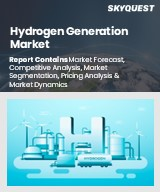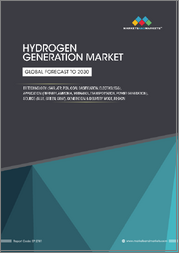
|
시장보고서
상품코드
1755521
수소 생성 시장 규모, 점유율, 성장 분석 : 기술별, 공급원별, 용도별, 지역별 - 산업 예측(2025-2032년)Hydrogen Generation Market Size, Share, and Growth Analysis, By Technology (Steam Methane Reforming (SMR), Coal Gasification), By Source (Grey Hydrogen, Blue Hydrogen), By Application, By Region - Industry Forecast 2025-2032 |
||||||
수소 생성 세계 시장 규모는 2023년에 1,588억 달러로 평가되었으며, 2024년 1,750억 달러에서 2032년에는 3,806억 1,000만 달러로 성장하여 예측 기간(2025-2032년) 동안 CAGR 10.2%로 성장할 전망입니다.
전 세계적으로 기후변화 대책이 강화되는 가운데 각국 정부는 온실가스 배출을 억제하기 위해 엄격한 규제를 의무화하고 있으며, 운송, 에너지, 중공업 등 온실가스 배출이 많은 부문은 청정에너지원으로 전환해야 하는 상황에 직면해 있습니다. 재생 가능한 자원을 원료로 하는 그린 수소는 탄소 중립적인 대체 에너지로서 매우 중요한 존재가 되고 있으며, 그 인프라와 기술에 대한 국제적인 투자가 집중되고 있습니다. 각국은 생산 규모 확대에 대한 인센티브를 제공하고, 파트너십을 맺어 수소 생산능력을 강화하며, 청정에너지 전환에서 수소의 역할을 강화하고 있습니다. 철강, 시멘트, 정유 등 이산화탄소 배출이 많은 산업에서 에너지 및 원료로 활용도가 높은 수소를 채택하고 있습니다. 특히 암모니아 생산 및 발전을 위한 수소 수요의 급증은 수소 기술 혁신을 촉진하고 저탄소 산업에 대한 투자를 가속화하며 시장 역학을 크게 향상시키고 있습니다.
목차
소개
- 조사 목적
- 조사 범위
- 정의
조사 방법
- 정보 조달
- 2차와 1차 데이터 방법
- 시장 규모 예측
- 시장 가정과 제한
주요 요약
- 세계 시장 전망
- 공급과 수요 동향 분석
- 부문별 기회 분석
시장 역학과 전망
- 시장 개요
- 시장 규모
- 시장 역학
- 성장 촉진요인과 기회
- 성장 억제요인과 과제
- Porters 분석
주요 시장 인사이트
- 핵심성공요인
- 경쟁 정도
- 주요 투자 기회
- 시장 생태계
- 시장 매력 지수(2024년)
- PESTEL 분석
- 거시경제 지표
- 밸류체인 분석
- 가격 분석
- 규제 상황
- 사례 연구
- 기술 분석
수소 생성 시장 규모 : 기술별 & CAGR(2025-2032년)
- 시장 개요
- 수증기 메탄 개질(SMR)
- 석탄 가스화
- 부분 산화(POX)
- 자가 열 개질(ATR)
- 전해
- 기타
수소 생성 시장 규모 : 공급원별 & CAGR(2025-2032년)
- 시장 개요
- 그레이 수소
- 블루 수소
- 그린 수소
수소 생성 시장 규모 : 용도별 & CAGR(2025-2032년)
- 시장 개요
- 정유소
- 암모니아 생산
- 메탄올 생산
- 운송
- 발전
- 기타
수소 생성 시장 규모 & CAGR(2025-2032년)
- 북미
- 미국
- 캐나다
- 유럽
- 독일
- 스페인
- 프랑스
- 영국
- 이탈리아
- 기타 유럽
- 아시아태평양
- 중국
- 인도
- 일본
- 한국
- 기타 아시아태평양
- 라틴아메리카
- 브라질
- 기타 라틴아메리카
- 중동 및 아프리카
- GCC 국가
- 남아프리카공화국
- 기타 중동 및 아프리카
경쟁 정보
- 상위 5개사의 비교
- 주요 기업의 시장 포지셔닝(2024년)
- 주요 시장 기업이 채용한 전략
- 최근의 시장 동향
- 기업의 시장 점유율 분석(2024년)
- 주요 기업 개요
- 기업 상세
- 제품 포트폴리오 분석
- 기업 부문별 점유율 분석
- 매출 전년비 비교(2022-2024년)
주요 기업 개요
- Air Liquide S.A.(France)
- Air Products and Chemicals, Inc.(U.S.)
- ENGIE S.A.(France)
- Saudi Arabian Oil Co.(Saudi Arabia)
- Iwatani Corporation(Japan)
- Orsted A/S(Denmark)
- Equinor ASA(Norway)
- Shell plc(UK)
- Chevron Corporation(U.S.)
- Exxon Mobil Corporation(U.S.)
- BP p.l.c.(UK)
- Petroliam Nasional Berhad(PETRONAS)(Malaysia)
- Siemens AG(Germany)
- Hiringa Energy Limited(New Zealand)
- Messer Group GmbH(Germany)
- Uniper SE(Germany)
- Iberdrola, S.A.(Spain)
- BayoTech Inc.(U.S.)
결론과 제안
ksm 25.07.03Global Hydrogen Generation Market size was valued at USD 158.8 billion in 2023 and is poised to grow from USD 175.0 billion in 2024 to USD 380.61 billion by 2032, growing at a CAGR of 10.2% during the forecast period (2025-2032).
As the global agenda intensifies to combat climate change, governments are mandating strict regulations to curb greenhouse gas emissions, prompting high-emission sectors like transport, energy, and heavy industries to transition to cleaner energy sources. Green hydrogen, derived from renewable resources, emerges as a pivotal carbon-neutral alternative, attracting significant international investments in its infrastructure and technology. Nations are incentivizing production scaling and forging partnerships to enhance hydrogen generation capabilities, reinforcing its role in the clean energy transition. Industries with large carbon footprints, such as steel, cement, and refining, are increasingly adopting hydrogen for its versatility in energy and feedstock applications. This surge in hydrogen demand, especially for ammonia production and power generation, is catalyzing innovations in hydrogen technologies and accelerating low-carbon industrial investments, enhancing market dynamics exponentially.
Top-down and bottom-up approaches were used to estimate and validate the size of the Global Hydrogen Generation market and to estimate the size of various other dependent submarkets. The research methodology used to estimate the market size includes the following details: The key players in the market were identified through secondary research, and their market shares in the respective regions were determined through primary and secondary research. This entire procedure includes the study of the annual and financial reports of the top market players and extensive interviews for key insights from industry leaders such as CEOs, VPs, directors, and marketing executives. All percentage shares split, and breakdowns were determined using secondary sources and verified through Primary sources. All possible parameters that affect the markets covered in this research study have been accounted for, viewed in extensive detail, verified through primary research, and analyzed to get the final quantitative and qualitative data.
Global Hydrogen Generation Market Segments Analysis
Global Hydrogen Generation Market is segmented by Technology, Source, Application and region. Based on Technology, the market is segmented into Steam Methane Reforming (SMR), Coal Gasification, Partial Oxidation (POX), Auto-Thermal Reforming (ATR), Electrolysis and Others. Based on Source, the market is segmented into Grey Hydrogen, Blue Hydrogen and Green Hydrogen. Based on Application, the market is segmented into Petroleum Refinery, Ammonia Production, Methanol Production, Transportation, Power Generation and Others. Based on region, the market is segmented into North America, Europe, Asia Pacific, Latin America and Middle East & Africa.
Driver of the Global Hydrogen Generation Market
The global hydrogen generation market is experiencing significant growth, largely fueled by government policies and regulations. Numerous nations have established ambitious targets for decarbonization, accompanied by financial incentives and grants aimed at advancing hydrogen production technologies. These initiatives not only facilitate the shift towards cleaner energy sources but also boost investments in green hydrogen infrastructure, ultimately decreasing dependency on fossil fuels. As a result, the supportive framework provided by governments is instrumental in propelling the hydrogen generation market forward, fostering innovation and encouraging the adoption of sustainable energy solutions across various sectors worldwide.
Restraints in the Global Hydrogen Generation Market
The global hydrogen generation market faces significant constraints due to its dependence on renewable energy sources such as wind and solar power for the production of green hydrogen. In areas where the infrastructure for renewable energy is either lacking or inconsistent, the ability to produce green hydrogen at competitive costs is hindered. This situation restricts the scalability and accessibility of green hydrogen in specific regions, ultimately impeding the overall growth of the global market. Consequently, the reliance on reliable and well-developed renewable energy systems is crucial for fostering expansion and facilitating widespread adoption of green hydrogen technologies worldwide.
Market Trends of the Global Hydrogen Generation Market
The global hydrogen generation market is experiencing a significant momentum shift, characterized by accelerated investment in green hydrogen projects. This trend is largely fueled by the urgent need for sustainable energy solutions and stringent carbon reduction targets set by governments worldwide. Both private and public sectors are channeling substantial funding into advanced electrolyzer technologies and the integration of renewable energy sources, further propelling the growth of green hydrogen production. This surge in investment not only enhances the viability of hydrogen as a clean energy alternative but also positions it as a pivotal element in the transition toward a low-carbon economy, thereby driving market expansion on a global scale.
Table of Contents
Introduction
- Objectives of the Study
- Scope of the Report
- Definitions
Research Methodology
- Information Procurement
- Secondary & Primary Data Methods
- Market Size Estimation
- Market Assumptions & Limitations
Executive Summary
- Global Market Outlook
- Supply & Demand Trend Analysis
- Segmental Opportunity Analysis
Market Dynamics & Outlook
- Market Overview
- Market Size
- Market Dynamics
- Drivers & Opportunities
- Restraints & Challenges
- Porters Analysis
- Competitive rivalry
- Threat of substitute
- Bargaining power of buyers
- Threat of new entrants
- Bargaining power of suppliers
Key Market Insights
- Key Success Factors
- Degree of Competition
- Top Investment Pockets
- Market Ecosystem
- Market Attractiveness Index, 2024
- PESTEL Analysis
- Macro-Economic Indicators
- Value Chain Analysis
- Pricing Analysis
- Regulatory Landscape
- Case Studies
- Technological Analysis
Global Hydrogen Generation Market Size by Technology & CAGR (2025-2032)
- Market Overview
- Steam Methane Reforming (SMR)
- Coal Gasification
- Partial Oxidation (POX)
- Auto-Thermal Reforming (ATR)
- Electrolysis
- Others
Global Hydrogen Generation Market Size by Source & CAGR (2025-2032)
- Market Overview
- Grey Hydrogen
- Blue Hydrogen
- Green Hydrogen
Global Hydrogen Generation Market Size by Application & CAGR (2025-2032)
- Market Overview
- Petroleum Refinery
- Ammonia Production
- Methanol Production
- Transportation
- Power Generation
- Others
Global Hydrogen Generation Market Size & CAGR (2025-2032)
- North America (Technology, Source, Application)
- US
- Canada
- Europe (Technology, Source, Application)
- Germany
- Spain
- France
- UK
- Italy
- Rest of Europe
- Asia Pacific (Technology, Source, Application)
- China
- India
- Japan
- South Korea
- Rest of Asia-Pacific
- Latin America (Technology, Source, Application)
- Brazil
- Rest of Latin America
- Middle East & Africa (Technology, Source, Application)
- GCC Countries
- South Africa
- Rest of Middle East & Africa
Competitive Intelligence
- Top 5 Player Comparison
- Market Positioning of Key Players, 2024
- Strategies Adopted by Key Market Players
- Recent Developments in the Market
- Company Market Share Analysis, 2024
- Company Profiles of All Key Players
- Company Details
- Product Portfolio Analysis
- Company's Segmental Share Analysis
- Revenue Y-O-Y Comparison (2022-2024)
Key Company Profiles
- Air Liquide S.A. (France)
- Company Overview
- Business Segment Overview
- Financial Updates
- Key Developments
- Air Products and Chemicals, Inc. (U.S.)
- Company Overview
- Business Segment Overview
- Financial Updates
- Key Developments
- ENGIE S.A. (France)
- Company Overview
- Business Segment Overview
- Financial Updates
- Key Developments
- Saudi Arabian Oil Co. (Saudi Arabia)
- Company Overview
- Business Segment Overview
- Financial Updates
- Key Developments
- Iwatani Corporation (Japan)
- Company Overview
- Business Segment Overview
- Financial Updates
- Key Developments
- Orsted A/S (Denmark)
- Company Overview
- Business Segment Overview
- Financial Updates
- Key Developments
- Equinor ASA (Norway)
- Company Overview
- Business Segment Overview
- Financial Updates
- Key Developments
- Shell plc (UK)
- Company Overview
- Business Segment Overview
- Financial Updates
- Key Developments
- Chevron Corporation (U.S.)
- Company Overview
- Business Segment Overview
- Financial Updates
- Key Developments
- Exxon Mobil Corporation (U.S.)
- Company Overview
- Business Segment Overview
- Financial Updates
- Key Developments
- BP p.l.c. (UK)
- Company Overview
- Business Segment Overview
- Financial Updates
- Key Developments
- Petroliam Nasional Berhad (PETRONAS) (Malaysia)
- Company Overview
- Business Segment Overview
- Financial Updates
- Key Developments
- Siemens AG (Germany)
- Company Overview
- Business Segment Overview
- Financial Updates
- Key Developments
- Hiringa Energy Limited (New Zealand)
- Company Overview
- Business Segment Overview
- Financial Updates
- Key Developments
- Messer Group GmbH (Germany)
- Company Overview
- Business Segment Overview
- Financial Updates
- Key Developments
- Uniper SE (Germany)
- Company Overview
- Business Segment Overview
- Financial Updates
- Key Developments
- Iberdrola, S.A. (Spain)
- Company Overview
- Business Segment Overview
- Financial Updates
- Key Developments
- BayoTech Inc. (U.S.)
- Company Overview
- Business Segment Overview
- Financial Updates
- Key Developments



















